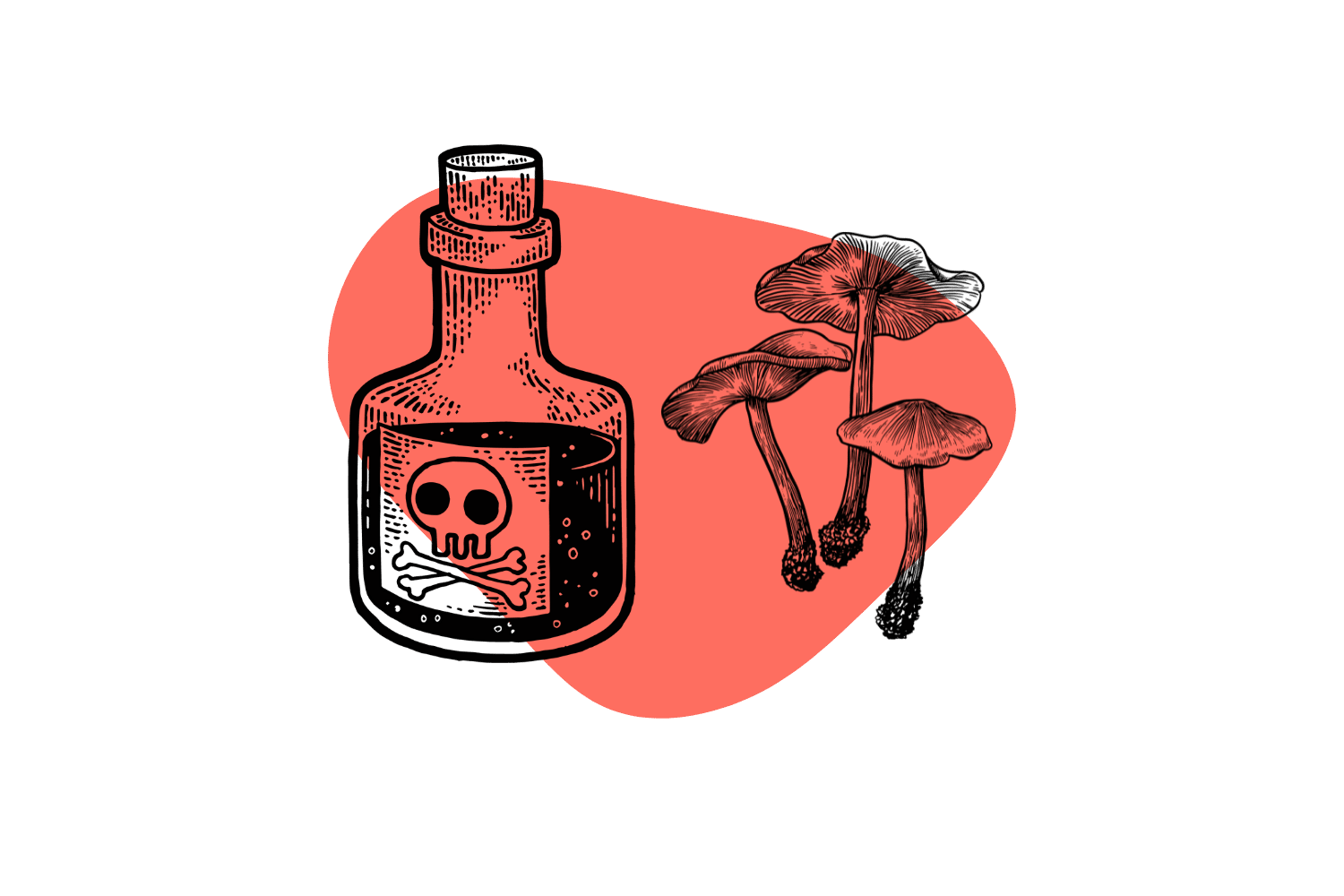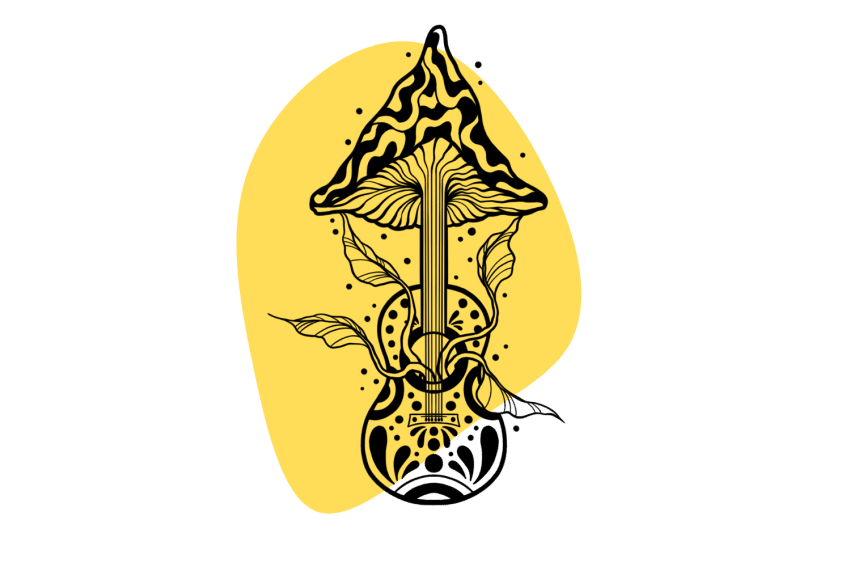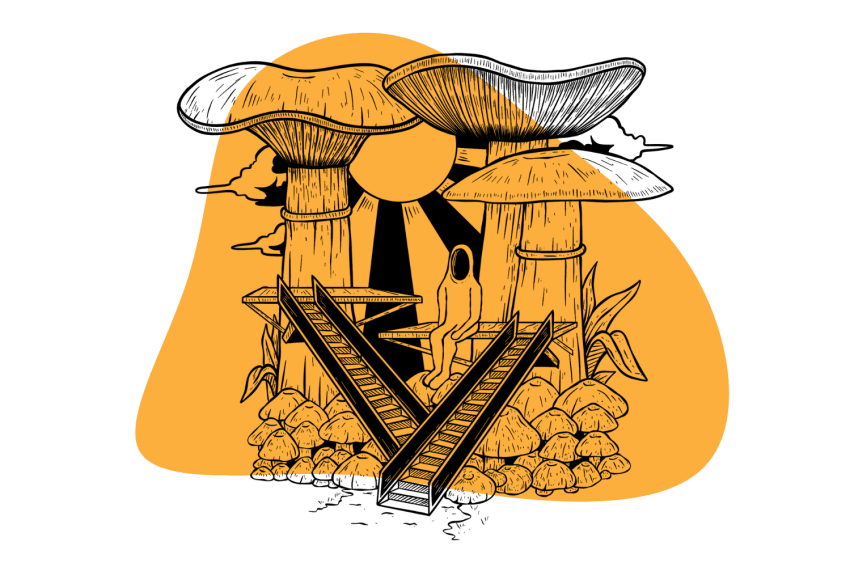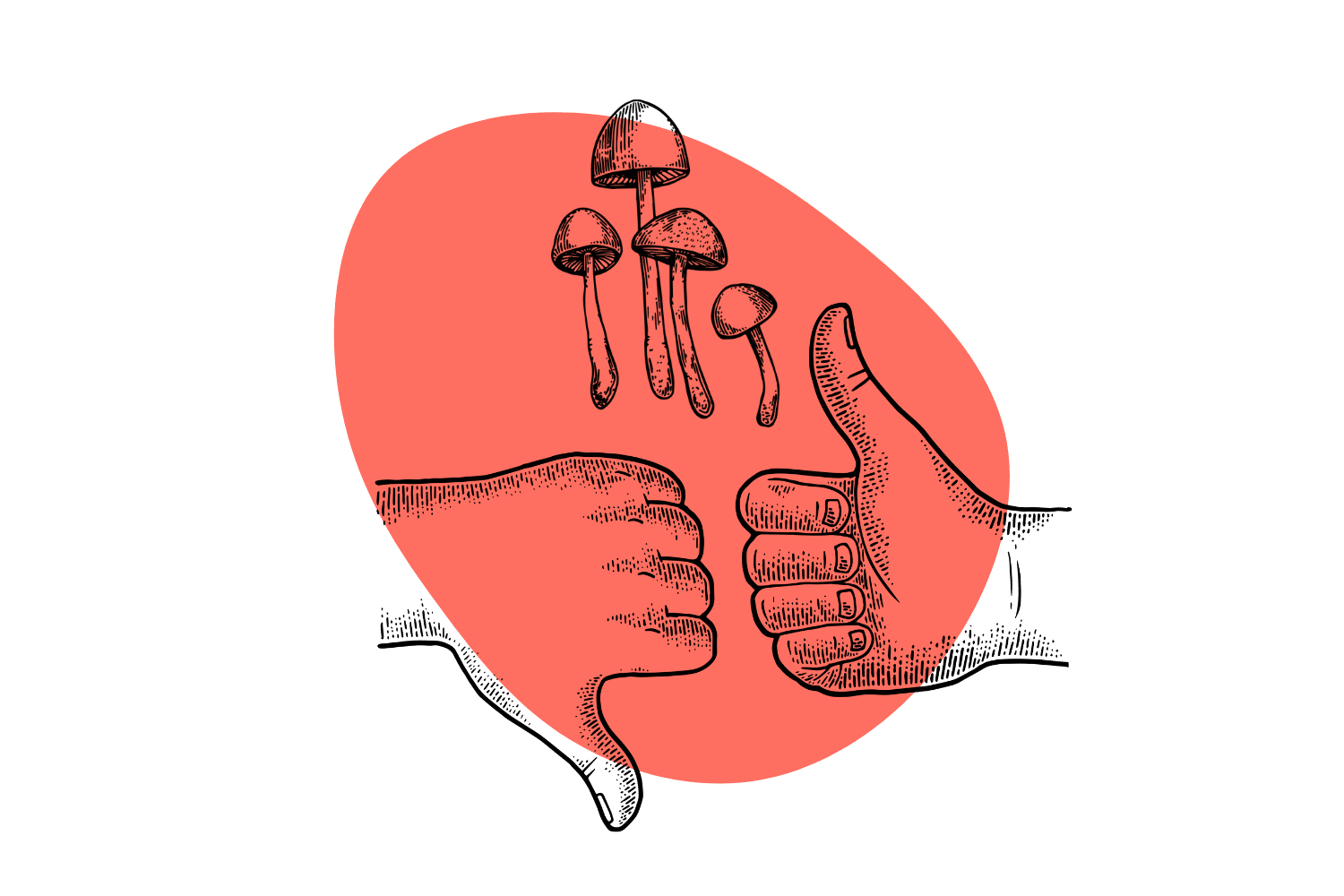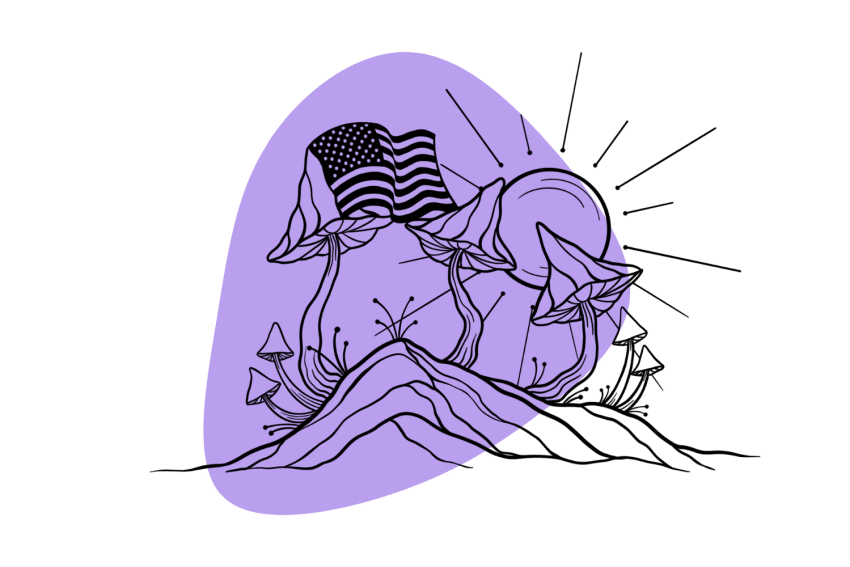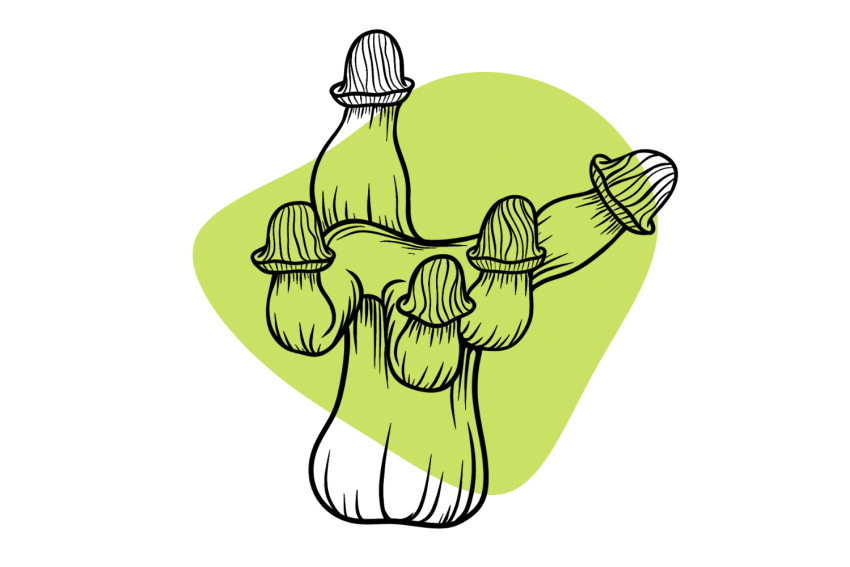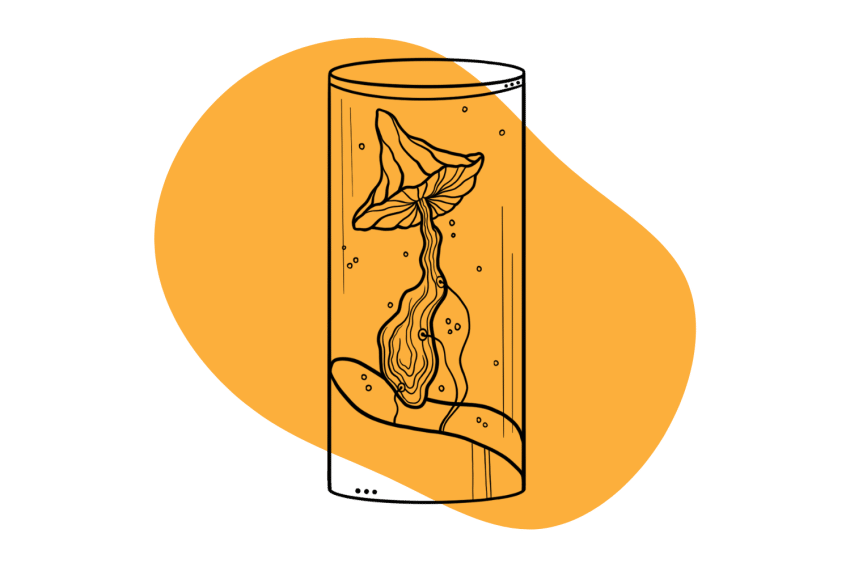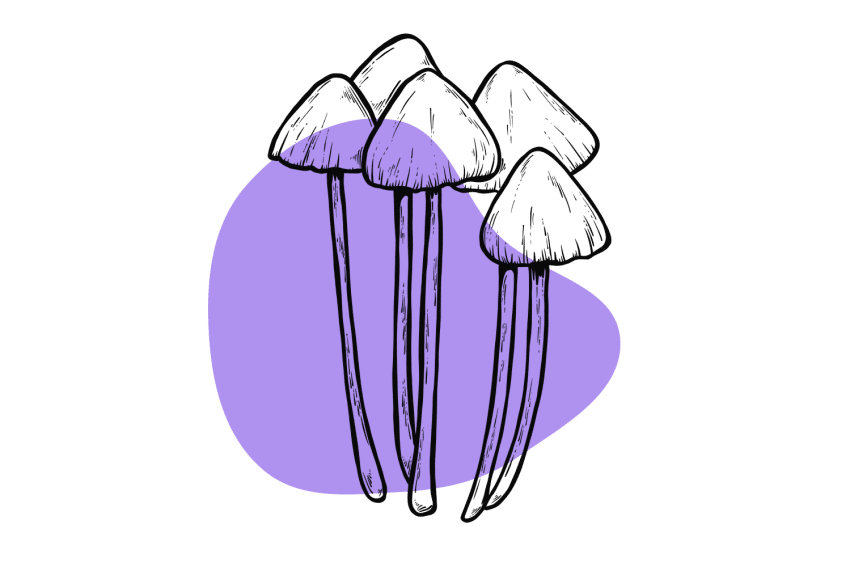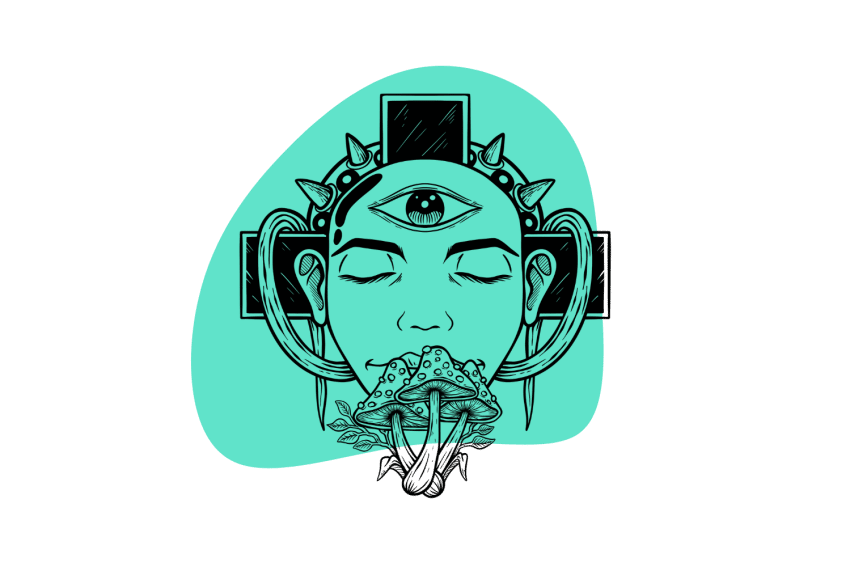Breaking the Mold: Psilocybin As A Possible ADHD Treatment
Magic mushrooms might not be the first medication you think of for ADHD treatment. However, studies suggest psilocybin may help curb the symptoms when used correctly.
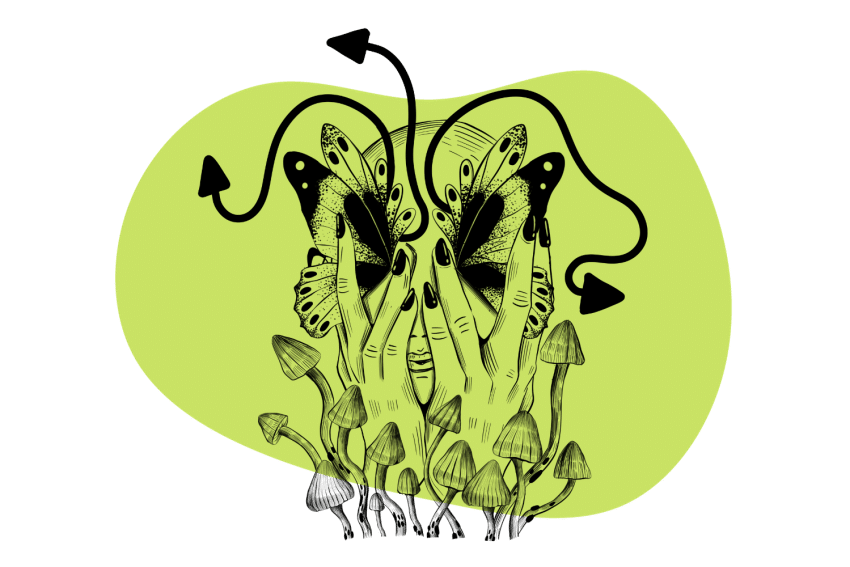
With more and more studies outlining the benefits of magic mushrooms for mental health, it’s no wonder people are looking towards them to curb the symptoms of ADHD (Attention Deficit Hyperactivity Disorder).
Although there’s very little scientific evidence to suggest that psilocybin is an effective treatment for ADHD, there’s plenty of anecdotal evidence.
In this article, we’ll look at the current research and find out how, if, and why psilocybin helps with ADHD symptoms. We’ll delve into consumption methods, doses, how psilocybin compares to traditional ADHD medications, and whether there are any risks associated with its use.
What is ADHD?
Attention Deficit Hyperactivity Disorder — or ADHD for short — is a neurodevelopmental disorder that affects attention and causes inappropriate levels of impulsivity and hyperactivity. It often appears in children and, in many cases, dissipates into adulthood. However, many people carry ADHD into adolescence and adulthood [1].
If ADHD goes unnoticed and is left untreated, it can cause various difficulties for those with it. Relationship problems, difficulty maintaining friendships, academic issues, low self-esteem, and substance abuse can all become issues if the condition is ignored.
ADHD Symptoms
There are several symptoms associated with ADHD. Not everyone experiences the same symptoms, and some are more common than others.
Although the symptoms of ADHD can vary from person to person, people with the disorder fit into both or one of the following categories:
- Predominantly inattentive — difficulty focusing or concentrating on tasks.
- Predominantly hyperactive & impulsive — difficulty sitting still with the urge to behave differently.
Some people with just the inattentiveness side of ADHD may be very cool-headed and calm. However, they may struggle academically and in working environments because they bend over backward to concentrate on a single task until completion.
Other people who have the hyperactive side of ADHD may (unsurprisingly) be more hyperactive and impulsive. These individuals may struggle to sit still and act on impulses without necessarily thinking about the potential consequences of their actions.
People with the inattentive, hyperactive, and impulsive traits of ADHD can experience a variety of symptoms, including the following:
- Carelessness
- Difficulty dealing with stress
- Difficulty keeping quiet
- Forgetfulness
- Impatience
- Inability to focus
- Irritability
- Lack of attention to detail
- Lack of priority
- Mood swings
- Often losing things
- Often starting new tasks before finishing previous tasks
- Poor organizational skills
- Restlessness
- Taking risks with little regard for safety
What Causes ADHD?
The causes of ADHD are not yet fully understood. However, a combination of factors is believed to be responsible for the disorder’s development.
ADHD is thought to be caused by a combination of genetic and environmental factors. It tends to run in families, with identical twins being more likely to both have the condition than non-identical twins [2, 3]. Siblings of individuals with ADHD are also more likely to have the condition than the general population.
Additionally, certain prenatal factors, such as viral infections, smoking, poor nutrition, and alcohol exposure, have been suggested as possible contributing factors to the development of ADHD [1].
What is Psilocybin?
Psilocybin is a psychoactive compound found in many different species of psychedelic fungi. This alkaloid is responsible for the psychedelic effects felt after ingesting high doses of species such as Psilocybe cubensis, Psilocybe semilanceata, and Psilocybe Mexicana.
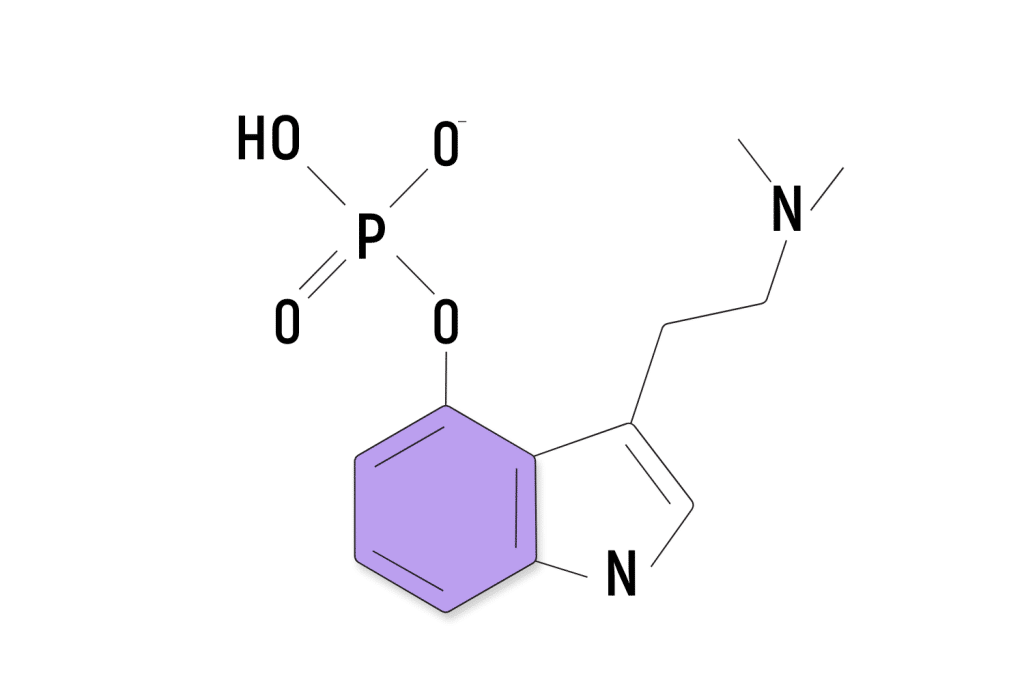
There are more than 180 different species of psilocybin-containing mushrooms growing across the globe. Psilocybin has been used for centuries in traditional ceremonies and rituals in different cultures worldwide.
Now, the compound is being widely studied for its potential to treat a variety of mental health conditions.
Psilocybin has proved to be effective in treating mental health conditions such as PTSD, anxiety, and depression. So, can you use psilocybin to help curb ADHD symptoms? Is it an effective treatment, and can it be used instead of more traditional ADHD medications?
Can You Use Psilocybin Instead of Traditional ADHD Medication?
The most common method of ADHD management involves amphetamines, such as Adderall and Ritalin. They address the disorder’s symptoms by increasing dopamine and norepinephrine in the brain. These medications are commonly available as slow-release tablets and require just one dose daily.
The problem with psychostimulants is that they carry a high risk of misuse [2]. When used often, amphetamine medications can become addictive, both physically and psychologically.
Often, the dose of these stimulants must be increased over time as the user’s tolerance increases. The rise in dosage also increases the chance of developing addiction and a whole host of other side effects.
Stimulant medications increase blood pressure, heart rate, and blood sugar levels. Some also find that these medications cause insomnia, disordered eating habits, and unproductive hyperfocus [3].
Of course, these medications work for many people, but they’re far from perfect and aren’t necessarily safe long-term.
Can psilocybin be used instead of Ritalin and Adderall?
So far, there’s very little substantial evidence supporting psilocybin use for ADHD symptoms. However, research into the matter is slowly growing.
Many people have found improvement in their ADHD symptoms through microdosing, to the point of replacing their stimulant medications.
There does seem to be some inconsistency in the anecdotal evidence available on the topic. Some people report fantastic results from psilocybin for ADHD; others report no effects or negative side effects, such as an increased loss of focus and motivation [4, 6].
We’re yet to find out exactly how and why psilocybin may work as an effective treatment for ADHD symptoms. Although psilocybin has no affinity for the dopamine D2 receptors, it does increase dopamine transmission in the striatum — something that stimulant medications such as Ritalin do.
Research into the effects of psilocybin on the disorder is increasing (we’ll look more into the current and upcoming research soon).
Psilocybin vs. Psychostimulants Comparison Table
| Psilocybin | Psychostimulants | |
| Mechanism of action | Binds to serotonin receptors (5-HT2A) in the brain | Increase dopamine, norepinephrine, & serotonin neurotransmitters in the brain |
| Legality | Schedule I Drug | Legal, Prescription-only |
| Dosage | 0.2 – 0.5 g | 5 – 60 mg (dependant on stimulant type) |
| Evidence | Low level (mostly anecdotal evidence with some early studies) | High level (scientifically studied since the 1950s) |
| Risk of side effects | Low to moderate | Moderate to high |
| Cost | $60 – $100 per month (average cost for dried magic mushrooms) | $300 – $500 per month (without insurance) |
What Does the Research Say?
There’s strong evidence to support the use of psilocybin for various brain and mental health disorders, including addiction and alcoholism, anxiety, depression, cluster headaches, and PTSD.
The evidence that magic mushrooms and psilocybin can treat ADHD isn’t as strong, but we already have a strong foundation justifying more research.
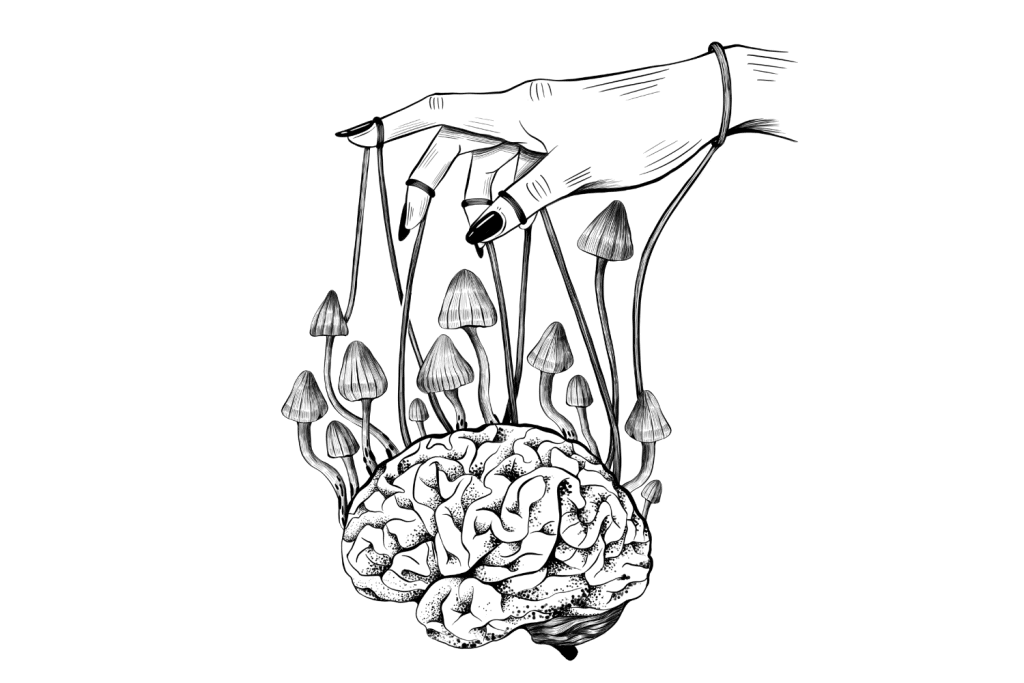
Here’s what evidence exists so far for the use of psilocybin for ADHD:
1. Psychedelics & Brain Function
A recent review paper compiled the current supporting evidence for psychedelics as a treatment for ADHD [4]. The paper reviewed preliminary evidence from the first-hand experiences of those who have replaced traditional psychostimulant ADHD medications with psychedelic microdoses — many of them psilocybin-containing mushrooms.
The review also looked into connections between the dysfunctional neural mechanisms associated with ADHD and the neural effects of psychedelics on brain function and behavior.
In the first chapter, both structural and functional brain impairments, as well as the neurotransmitter systems involved with ADHD, were outlined. These systems were assessed for comparison in Chapter 2, where the researchers would look at the structural and functional brain effects, neural mechanisms, and neurotransmitter systems associated with psychedelic substances. Researchers then began to make links to support psilocybin and other psychedelics in treating ADHD.
Chapter three examined the current research and data surrounding psychedelic microdoses. Experimental and anecdotal evidence was assessed, and although non-scientific, the case reports described psychedelic microdoses as “promising and potentially life-changing for people with ADHD.”
Here are some of the links made between psychedelics and ADHD in brain function:
- Some psychedelics can increase the expression of brain-derived neurotrophic factor (BDNF). Altered BDNF activity may be implicated in the development of ADHD because it leads to impairment in the dopaminergic system. With this in mind, BDNF restoration through psychedelic consumption may provide therapeutic effects in ADHD patients.
- Brain imaging studies revealed that psychedelics decrease activity in certain brain areas — specifically, the frontal and parietal regions. Both of these regions are involved with ADHD dysfunctions. The decrease of activity in these areas after the consumption of psychedelics may be of relevance to the disorder.
- Psychedelics can affect the limbic areas of the brain (the amygdala and hippocampus), decreasing activation in the regions. The amygdala, in particular, is responsible for fearful reactions from negative stimuli (impulses). The decrease in activity in this area may reduce the impulsive and hyperactive nature often seen in ADHD patients.
- Classic psychedelics — psilocybin & LSD in particular — decrease alpha and theta brain waves while increasing beta activity. This action is something that’s similar to the effects of stimulant medications such as Ritalin and Adderall. This implies that psilocybin could help reduce ADHD symptoms in a similar way that conventional medicine does.
The effects of psilocybin on serotonin may also play a part in the reduction of ADHD symptoms — specifically, focus and attention. The 5-HT2A serotonin receptor that psilocybin interacts with when ingested may be related to remission in ADHD, as one study suggests [7].
Evidence suggests that the stimulation of serotonergic function increases focus and sustains attention [12]. This could directly counter the common symptoms that affect attention span and the ability to focus in ADHD patients.
ADHD patients have significantly lower levels of the neurotransmitter dopamine in the brain. Dopamine plays a role in how we feel pleasure and is a big part of focus, attention, and general interests. Due to the lack of dopamine, people with ADHD are often unsatisfied, wired, unfocused, and “in search of more.” These attributes make it difficult for these people to concentrate on single tasks and focus for long periods without becoming distracted.
Although psilocybin has no affinity for the D2 dopamine receptors, one study has discovered that the substance increases dopamine transmission in the striatum through secondary increases in the neurotransmitter [13].
2. Anecdotal Evidence For Psilocybin Microdoses & ADHD
A retrospective study analyzed the results of a survey study of 159 participants with ADHD [5]. The study assessed the reports from the participants to see if ADHD symptoms would decline after microdosing was initiated.
The survey was advertised on microdosing.nl. Interested participants would click the link and contact the study researchers. After signing up, the participants were asked to provide accurate information in a baseline survey outlining their symptoms before taking their chosen psychedelic microdose.
Once the participants began microdosing, they would complete measurement surveys at two- and four-week intervals to provide their results and experiences to the researchers. The data collection occurred between November 2020 and July 2021.
The participants were presented with numerous online “tests” to outline their overall well-being, time perception, and severity of symptoms. Such questionnaires would help the researchers build a picture of the effectiveness of the participants’ self-medicated microdoses.
Around 78% of the participants reported using psilocybin in the form of magic mushrooms or truffles as their chosen psychedelic for microdosing. Most of these participants (exact percentage not specified) saw a decrease in ADHD symptoms within the two- and four-week intervals.
The authors concluded that there was a positive correlation between the change in ADHD symptoms and well-being after the participants began microdosing with psychedelics.
Another online survey exploring the effectiveness of psychedelics on ADHD showed promising results from first-hand reports [6].
The survey questioned 3,590 people who are currently microdosing psychedelics or have done so in the past. One thousand sixty-two people claimed to be microdosing psychedelics such as psilocybin, LSD, 1P-LSD, or MDMA to help treat their anxiety, depression, or ADHD symptoms.
79.2% of the 1,062 people had been prescribed conventional medications previously. Out of that 79.2%, around 70% preferred psychedelic microdoses over conventional medications. These participants claimed their symptoms had greatly lessened or dissipated entirely after as little as a single microdose of their chosen psychedelic.
The survey concluded that low-dose psychedelics might help alleviate the symptoms of several mental conditions, including ADHD.
3. The Long-Term Effects of Psilocybin Compared to ADHD Medication
Although there’s very little solid scientific data to support psilocybin use for ADHD, there are a few upcoming clinical trials.
The Washington University School of Medicine has an upcoming trial that will look at the immediate and long-term effects of psilocybin on the cortical and cortico-subcortical brain networks.
It’s a phase I trial that will employ functional brain imaging to discover the effects of psilocybin on the brain. The trial will look in depth at the effects of the drug on the 5-HT2A serotonin receptor.
The 5-HT2A serotonin receptor that psilocybin interacts with when ingested may be related to remission in ADHD, as one study suggests [7].
This trial isn’t ADHD-specific. However, it will be compared against a stimulant medication called methylphenidate — a drug often used to treat narcolepsy and ADHD.
Hopefully, the trial will uncover more information on how psilocybin interacts with the brain and its impact on human behavior. As the areas of the brain the scientists will look at are linked to many mental dysfunctions, it could lead to further study into psilocybin’s benefits for Attention Deficit Hyperactivity Disorder.
How To Use Magic Mushrooms for ADHD
Magic mushrooms can be consumed in several ways. If you want to treat ADHD symptoms, the most beneficial way to take magic mushrooms is to consume a sub-perceptual dose — a microdose. A psilocybin microdose will not induce any psychedelic effects.
Microdosing allows people to reap the potential benefits of the compound without altering consciousness. One can carry on with day-to-day activities without experiencing any psychedelic side effects.
So, how much is a microdose of psilocybin exactly?
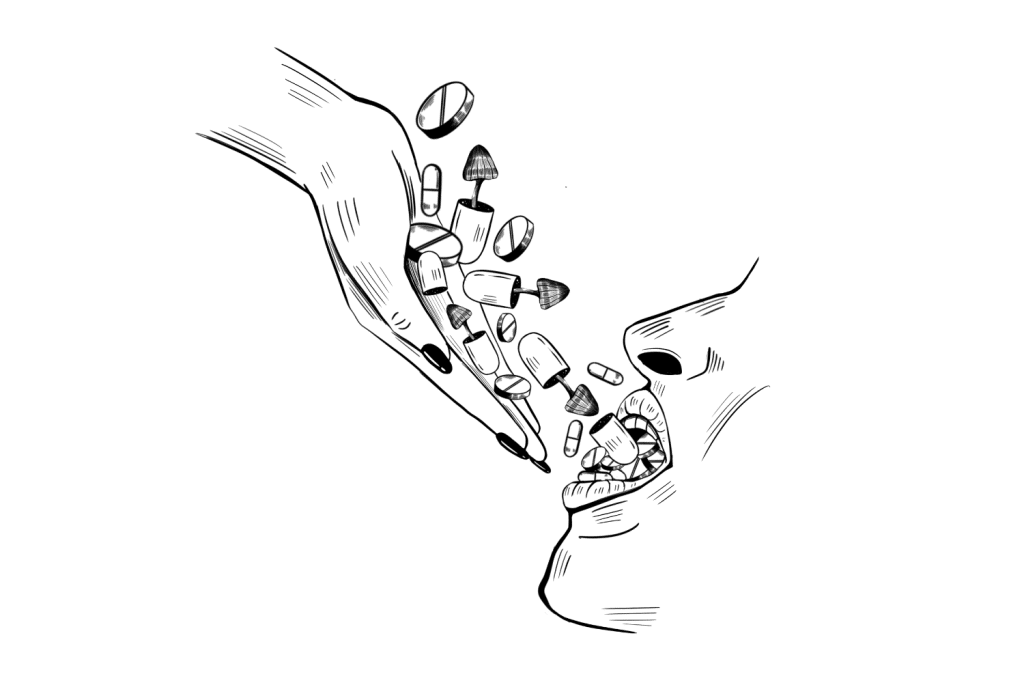
How Much is a Microdose?
Generally, a psilocybin microdose is around 1/10th of a psychedelic dose. For most people, two to five grams of dried magic mushrooms are enough for a psychedelic experience.
With this in mind, around 0.1 to 0.5 grams of dried mushrooms is considered a non-perceptual microdose that won’t induce psychedelic effects.
Learn More: Psychedelic Microdosing 101
When experimenting with microdosing, always start with a lower dose than you think is necessary and increase it slowly until you reach the desired effects.
You should avoid driving or going to work until you’re certain the psilocybin microdose you consumed is indeed a microdose. Once you’re familiar with how your body responds to the substance, it should be easy to gauge what an effective microdose is for you.
| Psilocybin Type | Psychedelic Dose | Microdose |
| Pure Psilocybin | 10–25 mg | 1–3 mg |
| Psilocybin (Dried Magic Mushrooms) | 2–5 g | 0.2–0.5 g |
How Can You Consume Psilocybin Microdoses?
Psilocybin microdoses can be consumed in several ways.
How you consume a psilocybin microdose is completely up to you. The consumption method isn’t particularly important. What’s more important is that you accurately measure the dosage.
Here are the most common ways to microdose psilocybin:
1. Microdosing Raw Mushrooms
If you have dried magic mushrooms, you can simply weigh your dose with a scale and swallow it with water. This is an effective way to consume psilocybin microdoses, but it isn’t something everyone will enjoy — it’s not particularly convenient, pleasant, or accurate.
2. Microdosing Psilocybin Chocolate
Psilocybin chocolate bars are available in areas with less strict legislation surrounding the substance. These edibles can be relatively accurately divided into sub-perceptual doses, making microdosing easier, more convenient, and tastier.
These chocolate bars usually contain around 3.5 grams of dried magic mushroom powder in total. This equates to seven to 15 individual microdoses depending on your chosen strength.
Alternatively, psilocybin chocolate bars can be made at home by combining an accurate measure of dried magic mushroom powder to the melted chocolate before letting the mixture set.
3. Microdosing Psilocybin Tinctures
Psilocybin tinctures are concentrated liquid extracts that are created by allowing psilocybin-containing fungi to sit in alcohol for an extended period of time. Tinctures are consumed by placing a drop or two of the liquid under the tongue so the psilocybin can be sublingually absorbed.
Tinctures are effective due to the increased bioavailability of psilocybin (more is absorbed into the body).
In order to accurately dose tinctures, you need to understand how potency works. Tinctures are normally measured in terms of the ratio of liquid to herb (in this case, dried magic mushrooms). General dosage information is listed below, but always follow the directions on the label.
General dosing guidelines for magic mushroom tinctures:
| Tincture Ratio | Equivalent Dose of 1 mL Tincture | Amount Needed For 200 mg Equivalent |
| 1:1 Tincture | 1.00 g Dried Mushrooms | 0.2 mL (~6 Drops) |
| 1:2 Tincture | 0.50 g Dried Mushrooms | 0.4 mL (~12 Drops) |
| 1:3 Tincture | 0.30 g Dried Mushrooms | 0.6 mL (~18 Drops) |
| 1:5 Tincture | 0.25 g Dried Mushrooms | 0.9 mL (~28 Drops) |
| 1:10 Tincture | 0.10 g Dried Mushrooms | 2 mL (~60 Drops) |
| 2:1 Tincture | 2 g Dried Mushrooms | 0.1 mL (~3 Drops) |
4. Microdosing Psilocybin Capsules
Psilocybin capsules are the most convenient and discreet way to consume psilocybin microdoses. This is the most common format you’ll find online.
Magic mushroom capsules offer more precise dosing, eliminate the bad taste of mushrooms, and often combine other synergistic ingredients such as lion’s mane mushroom, B vitamins, or L-theanine.
You can also make DIY microdose capsules by filling them yourself, either by hand or with a capsule machine.
What Are the Risks of Microdosing Psilocybin?
Although many people are turning to psilocybin because they’re fed up with stimulant medications’ harmful and potentially dangerous side effects, psilocybin also carries some risks.
The most common risks of psilocybin microdosing include:
- Accidentally taking too much — thus experiencing psychedelic effects
- Legal repercussions — this depends on the magic mushroom laws where you live
- Anxiousness — even microdoses can induce anxiety in some users. Avoid consuming caffeine and consider combining your microdose with L-theanine if you experience this side effect)
- Valvular Heart Disease (VHD) — there’s some evidence that long-term microdosing could cause damage to the heart valves (unproven)
The biggest risk with microdosing psilocybin for ADHD is the possibility of taking too much. While you can’t overdose on psilocybin, you will feel high if you take too much. This can be a problem for people who aren’t ready for a psychedelic experience.
Moreover, evidence suggests that using psilocybin regularly over many years could increase the risk of developing valvular heart disease (VHD for short). Since psilocybin is a 5-HT2B antagonist, it may produce similar long-term issues to other serotonergic medications like the now-discontinued Pondimin and Redux [8, 9].
Other Psychedelics That May Help ADHD
Psilocybin isn’t the only psychedelic substance that shows positive traits suited to treating ADHD symptoms. Microdosing other psychedelic substances such as LSD, 4-AcO-DMT, and mescaline could help curb ADHD symptoms for all the same reasons.
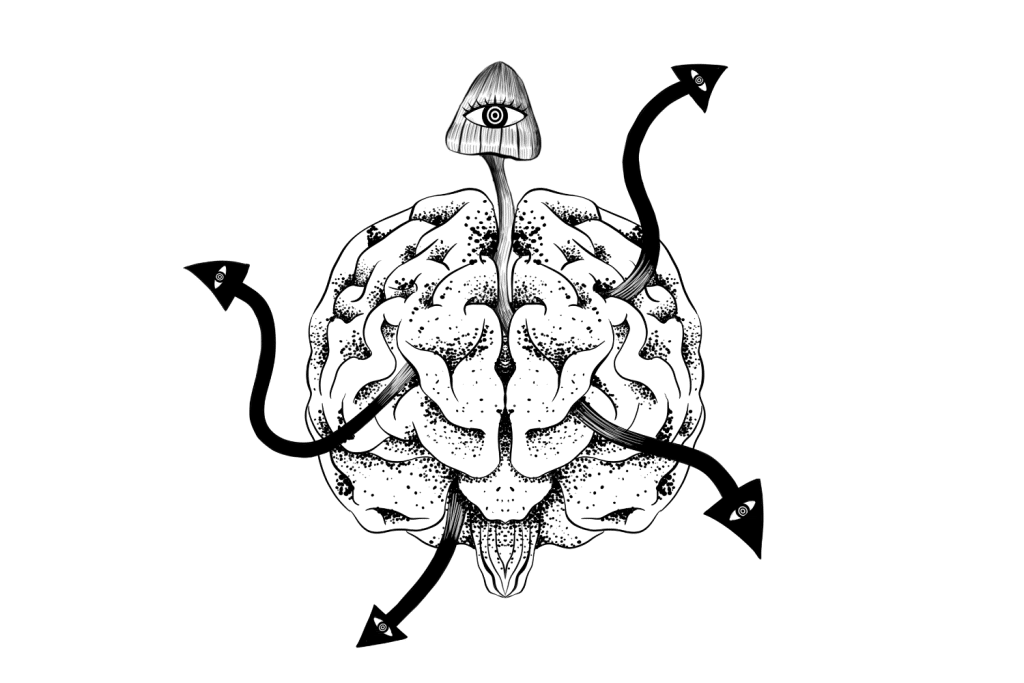
1. Tryptamine Psychedelics
Psilocybin is a psychedelic that’s in the tryptamine class. Tryptamines are a class of compounds that are similar in structure to serotonin.
Not all tryptamine psychedelics interact with the exact same receptors, but most interact with the serotonin 5-HT groups. The interaction with this set of receptors as well as a range of other traits that affect brain function (mentioned earlier), implies that other members of this class may help reduce ADHD symptoms.
The most promising agents include the psilocin prodrug 4-AcO-DMT as well as LSD and other lysergamide psychedelics such as PRO-LAD, ETH-LAD, PARGY-LAD, LSZ, and 1P-LSD.
Very strong psychedelics, such as N,N,DMT, and 5-MeO-DMT, are not likely to offer much help for ADHD in the form of microdoses.
2. Phenethylamine Psychedelics
The phenethylamine psychedelics share a lot in common with tryptamines, but they have a different base structure and have slight differences in how they interact with dopamine and serotonin receptors in the brain. This chemical family maintains similar psychedelic activity but also features a stronger stimulating action. This stimulant effect could make phenethylamines even more effective for managing ADHD than tryptamines like psilocybin.
Mescaline is the quintessential phenethylamine, from which a variety of other psychedelic compounds have been modeled. The largest family is the 2CX group, many of which offer an intersection between the serotonergic tryptamines and the dopaminergic amphetamines that make them especially interesting for use with ADHD.
Unfortunately, there isn’t much research on this chemical class for managing ADHD yet.
The most common phenethylamine psychedelics are:
- Mescaline (the active component in the peyote cactus)
- 2C-B (4-bromo-2,5-dimethoxyphenethylamine)
- 2C-E (4-ethyl-2,5-dimethoxyphenethylamine)
- 2C-B-FLY (2-(8-bromo-2,3,6,7-tetrahydrofuro[2,3-f] [1]benzofuran-4-yl)ethanamine)
3. Amphetamine Psychedelics & Other Stimulants
Amphetamines like Vyvanse (lisdexamfetamine) and Adderall (amphetamine) are proven treatments for ADHD. These drugs work by increasing dopamine activity in the brain.
Most amphetamines primarily target dopamine and norepinephrine, but a few also interact with serotonin, similar to the tryptamine and phenethylamine psychedelics. The best example is MDMA (3,4-methylenedioxy-N-methylamphetamine) or other MDXX substances.
Other amphetamine psychedelics include synthetic cathinones like MDPV or alpha-PVP, DOX compounds like DOB, DOM, or DOI, and fluorinated amphetamines like 2-FA, 2-FMA, or 4-FA.
None of these substances have been tested for use with ADHD, and all carry their own risk of side effects — especially if used long-term or in high doses.
Other natural psychostimulants are sometimes used instead, such as coca leaf, kratom, khat, or caffeine-containing herbs like yerba maté or coffee [14].
Several stimulants work in a similar way to conventional ADHD medications. Some of these substances may be a safer alternative to Ritalin and Adderall; others may be riskier.
References
- Fawns, T. (2021). Attention Deficit and Hyperactivity Disorder. Primary Care: Clinics in Office Practice, 48(3), 475-491.
- McDougall, M. R., Hay, D. A., & Bennett, K. S. (2006). Having a co-twin with attention-deficit hyperactivity disorder. Twin Research and Human Genetics, 9(1), 148-154.
- Chen, Q., Brikell, I., Lichtenstein, P., Serlachius, E., Kuja‐Halkola, R., Sandin, S., & Larsson, H. (2017). Familial aggregation of attention‐deficit/hyperactivity disorder. Journal of Child Psychology and Psychiatry, 58(3), 231-239.
- Berman, S. M., Kuczenski, R., McCracken, J. T., & London, E. D. (2009). Potential adverse effects of amphetamine treatment on brain and behavior: a review. Molecular psychiatry, 14(2), 123-142.
- Martin, D., & Le, J. K. (2020). Amphetamine.
- Totomanova, Iva. (2020). Psychedelics as a Potential Treatment Option in ADHD.
- Haijen, E. C., Hurks, P. P., & Kuypers, K. P. (2022). Microdosing with psychedelics to self-medicate for ADHD symptoms in adults: A prospective naturalistic study. Neuroscience Applied, 1, 101012.
- Hutten, N. R., Mason, N. L., Dolder, P. C., & Kuypers, K. P. (2019). Self-rated effectiveness of microdosing with psychedelics for mental and physical health problems among microdosers. Frontiers in psychiatry, 10, 672.
- Li, J., Kang, C., Wang, Y., Zhou, R., Wang, B., Guan, L., … & Faraone, S. V. (2006). Contribution of 5-HT2A receptor gene-1438A> G polymorphism to outcome of attention‐deficit/hyperactivity disorder in adolescents. American Journal of Medical Genetics Part B: Neuropsychiatric Genetics, 141(5), 473-476.
- Rothman, R. B., & Baumann, M. H. (2009). Serotonergic drugs and valvular heart disease. Expert opinion on drug safety, 8(3), 317-329.
- Connolly, H. M., Crary, J. L., McGoon, M. D., Hensrud, D. D., Edwards, B. S., Edwards, W. D., & Schaff, H. V. (1997). Valvular heart disease associated with fenfluramine–phentermine. New England Journal of Medicine, 337(9), 581-588.
- Wingen, M., Kuypers, K. P., van de Ven, V., Formisano, E., & Ramaekers, J. G. (2008). Sustained attention and serotonin: a pharmaco‐fMRI study. Human Psychopharmacology: Clinical and Experimental, 23(3), 221-230.
- (2016). Psilocybin. Meyler’s Side Effects of Drugs (Sixteenth Edition), 1048-1051.
- Vázquez, J. C., Martin de la Torre, O., López Palomé, J., & Redolar-Ripoll, D. (2022). Effects of caffeine consumption on Attention Deficit Hyperactivity Disorder (ADHD) treatment: A systematic review of animal studies. Nutrients, 14(4), 739.

